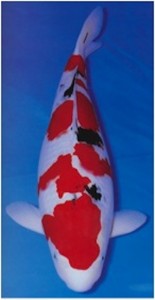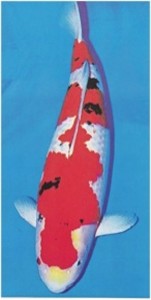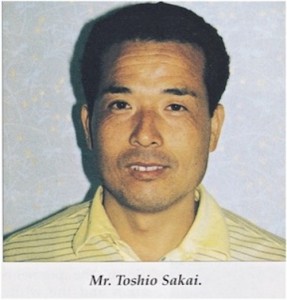Chapter Twelve.
Thankfully for Waddy, Toshio’s predictions that ‘Koi Kichi’ would be a hit and produce much ‘Gapo Gapo’ were correct but even the man himself underestimated the sales that were to follow. It later turned out to be the biggest selling Koi book ever produced.
I had taken a brave gamble on the actual sales of the book in the UK and decided not to let other UK Koi outlets buy from me at trade prices. Instead it could only be purchased direct from my company Infiltration at the retail price of £39.95.
I had unwittingly started what was later to be known as ‘the Koi industry’ back in ’77 and by 1995 there were many Koi dealers who considered that buying something for £10.00 and selling it for £9.00 was a wise move because a ‘loss leader’ would draw more custom to their outlets.
‘Koi Kichi’ would have been the perfect loss leader for these outlets, had I sold it to them they would have sold it for half the price they paid and that would have destroyed the product completely.
However, whilst the sales of the book were quite sobering for me, the spin-offs that followed as a direct result of the book were staggering!
Even in 1995 the name of Matsunosuke was only known by a handful of amateur Koi fanatics outside of Japan and the name of Toshio Sakai was hardly known at all. That also applied to Hiroji Sakai in Hiroshima who had few overseas customers other than Koi dealers. As to the others in the book such as Hasegawa; Miyatora; Choguro and Torazo etc. very few overseas enthusiasts had ever heard these names mentioned.

There is a very rough map of Yamakoshi in Koi Kichi (together with texts that highlighted the villages), which was sketched out for me by Hiroshi Kawakami of Torazo one afternoon and later modified by Satoru Hoshino, a local Koi historian of note.
I mentioned in the book that a visit to this area would be worthwhile for overseas visitors although I knew it was still almost a ‘closed shop’ controlled in the main part by Japanese Koi agents who were determined to hang on to it for as long as possible.
By then I had long since owned the key to Yamakoshi by doing everything alone and could buy my Koi from any breeder I chose and ship them all back to the UK unaided by others.
(This is Matsunosuke-related but needs explanations.)
I had always stayed at the Grand Hotel in Nagaoka whenever I visited Niigata and by ’95 the manager had given me free storage for all my computer equipment and spare clothing etc. and this allowed me to travel to and from Japan with the minimum of baggage, in fact all I carried onto the plane was a single cabin bag. I also knew all the staff there and by then knew every part of the city much better than my own hometown.
Just after Christmas in ’95 I had a telephone call from Onozuka san, manager of the Grand Hotel to tell me that a large party from the Philippines had arrived and reserved the Crown Suite and the Royal Suite for one week. The man in charge had shown him a copy of Koi Kichi and opened it to reveal the map; the purpose of the visit was to buy Koi and he wished to get to Uragara village the following day for starters.
Although Torazo is a honest as the day is long, there were some other unsavoury outlets in Uragara village, which I had long-since christened ‘Koi Ginza’, who were always on the lookout for passing trade especially from overseas Koi visitors.
I asked Onozuka san to jot down a few very important instructions, namely to get the party directly to Torazo and then get Torazo to direct them to Izumiya and then get Izumiya to direct them to Yamamatsu, Onozuka san spoke perfect English and he could relate my instructions to the party. It was the best advice I could possibly give to them.
I had forgotten the matter until another phone call came in February ’96 from the guy in the Philippines himself who had jotted down my number at the Grand Hotel. He rang to thank me for the book and said it allowed him to purchase Koi directly from the breeders and have them shipped to him by ‘a very kind friend he’d met in Uragara’.
I really didn’t need to ask; I just knew ‘the friend’ he’d found but I did ask and I was correct – my heart sank, yet another sucker had been snared!
He then started telling me about a wonderful five-year 85cms Doitsu Shiro Utsuri his friend had found him that was now swimming in his pond alongside Koi from Torazo; Izumiya; Yamamatsu and many other breeders his friend had kindly taken him to.
It was better simply to congratulate the guy rather than go into details. The guy believed he had by-passed all the dealers and agents and bought his Koi at base market price when I knew the exact opposite was the truth of it all. I shuddered to think of the prices he’d paid for his Koi on that trip.
(I first saw the Doitsu Shiro Utsuri in Himeji in 1984 and it was truly magnificent. A wealthy meat importer owned her along with hundreds of others all in the same class. He passed away in 1990 and the man’s agent in Uragara – the very same man in question, sold all his Koi on a commission-only basis on behalf of the widow. Den and I had seen the Koi there several times and had been offered it for peanuts as the guy was desperate to get rid of it. I have never bought a Koi from this guy but the five year-old Koi was closer to 18 years old if the truth was known! I did see that Koi later in the Philippines but that’s another story.)
The real reason he’d telephoned me was another attempt to by-pass his local dealers and Japanese agents but this time he wished to buy Koi from Toshio Sakai as he’d read every word I’d written about him in Koi Kichi.
He asked me if he could meet me in Isawa on my next trip in spring ’96 to find Koi and gave me his name for the first time. I replied that I’d be pleased to show him around Toshio’s stocks and stocks of other breeders in the area but I would have to charge my commission on any purchases made. He readily agreed to this and we set a date where we would meet up in Isawa in April, I even gave him Toshio’s telephone number just in case he needed it.
I sent a few emails to guys I knew in the Philippines who all warned me to stay well away from the guy. It turned out that he wasn’t merely ‘wealthy’ – he was mega-wealthy and owned the largest bank in the country! Others warned me that he would do anything possible to avoid paying any commissions at all and instead would go direct to Toshio.
Bingo! About a week later an email arrived from Toshio asking me about a guy from the Philippines who had mentioned my name. He wished to visit him soon and be collected from and returned to Narita after making his purchases. Toshio was more concerned with the waste of time more than anything, the road drive from Isawa to Narita and return means driving through Tokyo twice and unless there was a fair chance the guy was intent on buying good Koi then it wasn’t worth all the time and expense involved.
I sent my email reply back knowing it would be translated perfectly by the lady he knew. I explained it all to him and the fact I was pretty annoyed he’d tried to by-pass me but I urged him to collect the guy because he was a serious buyer. I got a reply from Toshio, which simply read ‘Thank you, Igarashi san will collect him from Narita.’
Den and I returned to Isawa in April ’96 with two guests from the UK where Toshio was already benefitting substantially from the successes of his Supreme Champions at the All-Japan in ’94 and ’95. He may have been a great name with the Koi breeders of Japan for many years but now the man was becoming truly International and deservedly so.
He knew he would also have to become much more of ‘a personality’ and attempt to hide the natural shyness that was and is Toshio. A few words of English and a few more smiles would be more than good for starters.
His foresight and labours in producing his ‘Magoi Lines’ had proved to many that he was a true visionary in the Japanese Koi world. He’d not only produced another bloodline, instead, if the truth was known he’d produced another SPECIES of coloured carp!

This is the ‘oval’ skeleton of Nishikigoi that were around at the times of the original Matsunosuke Sanke, the problem was, few exceeded 72cms when fully grown.

This is the ‘cigar’ skeleton of very early ‘Matsunosuke Magoi Sanke’, some of which would attain 100cms and in later years exceeded this.
His Goshiki and Sumi Goromo Goshiki production was significant by then but world class specimens were to follow later.
As to the two perfect Yamabuki and Showa goldfish mentioned earlier; these were now over 15” long and swimming in one of the main ponds. I pointed them out to the guys with me as Toshio came over and said ‘Kingyo NO Gapo Gapo’. Later that night he explained that he held a tiger by the tail with these but once he sold one – even for a high price – the buyer could easily produce thousands. He had decided to let the secret remain with him and would keep both of them at Isawa for life.
Just before the four of us left to meet the delightful Bagpuss, Toshio said ‘Petah san, Filipino gaigin, cash?’ I replied ‘Cash no – Nishikigoi OK.’ He smiled and said ‘Ah, Petah san – Gapo-Gapo!’ I smiled and nodded.
Toshio studied the Koi in his main pond whilst Igarashi san brought a bowl and a net. He handed the net to me and put his index finger in the air. This meant I could select any one Koi out of the pond as payment for the commission due to me from my man in Manila.
There were some wonderful Koi in that pond of tea-coloured water. It took me ten minutes to survey them all but my eyes returned to one Kohaku that was over 75cms. We placed it in the bowl, I looked at Den who was salivating already. Toshio came over, looked at the Koi and said ‘Oh Petah san, Gapo-Gapo-Gapo-Gapo’!
Result! I walked out to the street outside, raised my arms in a direction I considered Manila to be and screamed ‘Thank You Mr. Philippino!’
Den drove us to the Sun Plaza, I’d already told the two guys that Bagpuss was mine; they were not impressed with my advance description of her at all. By then the Sun Plaza had ‘got modern’ and had its own minimarket, the guys bought beer and we sat outside discussing the days experiences.
Toshio collected us all that night and took us to a respectable Chinese restaurant for a change, the food was good but the food at the shed was better. During the meal one of the guys asked if there were late night strip clubs in Isawa.
Long and short of it all, we ended up in a strip club which specialised in ladies of Russian origin. The place looked like a disused cinema with upholstered cinema seats and subdued lighting. Ladies brought beers and we watched as the girls did the things that girls do to grab the attention of the guys – and it worked!
I looked to my right to see how Toshio was enjoying the show.
He was fast asleep!




